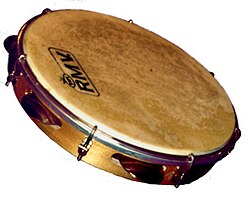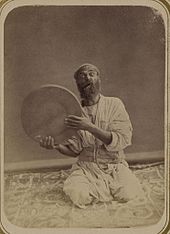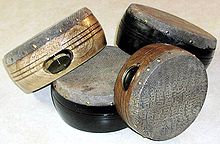
A percussion instrument is a musical instrument that is sounded by being struck or scraped by a beater including attached or enclosed beaters or rattles struck, scraped or rubbed by hand or struck against another similar instrument. Excluding zoomusicological instruments and the human voice, the percussion family is believed to include the oldest musical instruments. In spite of being a very common term to designate instruments, and to relate them to their players, the percussionists, percussion is not a systematic classificatory category of instruments, as described by the scientific field of organology. It is shown below that percussion instruments may belong to the organological classes of idiophone, membranophone, aerophone and chordophone.
A hand drum is any type of drum that is typically played with the bare hand rather than a stick, mallet, hammer, or other type of beater.

Daf, also known as dâyere and riq, is a Middle Eastern frame drum musical instrument, used in popular and classical music in South and Central Asia. It is also used in Afghanistan, Azerbaijan, Tajikistan, Iran, Uzbekistan, many regions of Georgia, Pakistan as well as in parts of India and Russian polar regions. It is also popular among Balkans, Bukharan Jews, Caucasians, Kurds, and Macedonians.
Northwest Iberian folk music is a traditional highly distinctive folk style, located along Spain's north-west Atlantic coast, mostly Galicia and Asturias, that has some similarities with the neighbouring area of Cantabria. The music is characterized by the use of bagpipes.

Zills or zils, also called finger cymbals, are small metallic cymbals used in belly dancing and similar performances. They are called sāgāt in Egypt. They are similar to Tibetan tingsha bells. In Western music, several pairs can be set in a frame to make a tambourine.
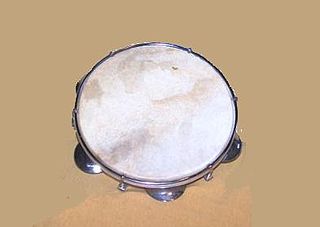
The pandeiro is a type of hand frame drum popular in Brazil. The pandeiro is used in a number of Brazilian music forms, such as samba, choro, coco, and capoeira music.
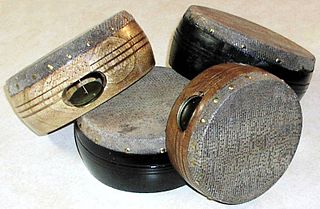
The kanjira, khanjira, khanjiri or ganjira, a South Indian frame drum, is an instrument of the tambourine family. As a folk and bhajan instrument, it has been used in the Indian subcontinent for many centuries.
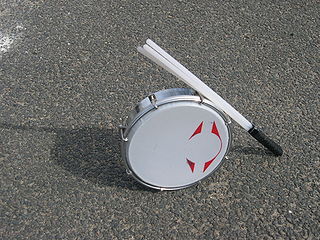
A tamborim is a small round Brazilian frame drum, developed from other similar percussive instruments bought by the Portuguese.

Dappankuthu is a folk dance and music genre with an emphasis on percussion performed in the South Indian state of Tamil Nadu. It is one of several popular genres employed in film music, mainly in Tamil cinema and other South films, filmed and produced by people of Tamil culture. It has been imported to Telugu culture and cinema under the Telugu name teenmaar.
Bandari music stems from Iran's south, around the Persian Gulf region.

The various nations of the region include the Arabic-speaking countries of the Middle East, the Iranian traditions of Persia, the Jewish music of Israel and the diaspora, Armenian music. Azeri Music, the varied traditions of Cypriot music, the music of Turkey, traditional Assyrian music, Coptic ritual music in Egypt as well as other genres of Egyptian music in general. It is widely regarded that some Middle-Eastern musical styles have influenced Central Asia, as well as the Balkans and Spain.
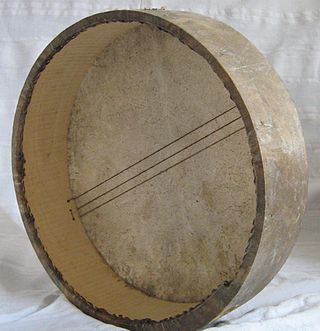
The bendir is a wooden-framed frame drum of North Africa and Southwest Asia.

The timbrel or tabret was the principal percussion instrument of the ancient Israelites. It resembled either a frame drum or a modern tambourine.

A frame drum is a drum that has a drumhead width greater than its depth. It is one of the most ancient musical instruments, and perhaps the first drum to be invented. It has a single drumhead that is usually made of rawhide, but man-made materials may also be used. Some frame drums have mechanical tuning, while on many others the drumhead is tacked in place. The drumhead is stretched over a round, wooden frame called a shell. The shell is traditionally constructed of rosewood, oak, ash etc. that has been bent and then scarf jointed together; though some are also made of plywood or man-made materials. Metal rings or jingles may also be attached to the frame. In many cultures larger frame drums are played mainly by men in spiritual ceremonies, while medium-size drums are played mainly by women.
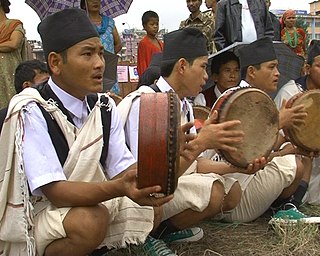
A damphu, or damfoo, is a percussion instrument similar to a large tambourine. This instrument is used by the Tamang people of Nepal to play the melodious Tamang Selo. According to folklore Damphu was invented by Peng Dorje, a Tamang King and named it after Nepal's national bird the Daphne bird. It is also played by the gurung and manger people of nepal.

Hand percussion is a percussion instrument that is held in the hand. They can be made from wood, metal or plastic, bottles stops and are usually shaken, scraped, or tapped with fingers or a stick. It includes all instruments that are not drums or pitched percussion instruments such as the marimba or the xylophone.

The bodhrán is a frame drum used in Irish music ranging from 25 to 65 cm (10–26 in) in diameter, with most drums measuring 35–45 cm (14–18 in). The sides of the drum are 9–20 cm deep. A goatskin head is tacked to one side. The other side is open-ended for one hand to be placed against the inside of the drum head to control the pitch and timbre.

The headless tambourine is a percussion instrument of the family of idiophones, consisting of a frame, often of wood or plastic, with pairs of small metal jingles. It differs from the standard tambourine by not having a drumhead. It creates sound primarily by way of the instrument vibrating itself, without the use of strings or membranes. Headless tambourines come in different shapes with the most common being circular. It is used in many forms of music, like gospel, pop and rock music. They are called "headless" because they lack the drumhead, that is, the skin stretched over one side of the ring in a traditional tambourine. Jazz, pop and rock drummers sometimes mount a headless tambourine in the drum kit.

Aram of the Two Rivers is an album by bass guitarist Jonas Hellborg that was released in 1999 by Bardo Records.

A riddle drum is a makeshift frame drum used in traditional English folk music. Originally, they were large agricultural riddle sieves used for winnowing corn, made from sheepskin stretched across a wooden frame. Agricultural workers found these made excellent percussion instruments, and developed unique rhythms and playing styles.
